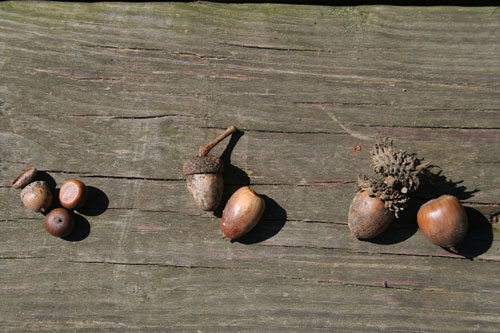 What of these acorns from the white oaks and red oaks? What is their benefit to wildlife? When do they fall and how can they enhance hunting? The answers to these and other questions are broad. These alone could fill a book. But be advised that acorns can be of great importance to all involved.
What of these acorns from the white oaks and red oaks? What is their benefit to wildlife? When do they fall and how can they enhance hunting? The answers to these and other questions are broad. These alone could fill a book. But be advised that acorns can be of great importance to all involved.
A relatively short answer to acorns’ benefit to wildlife is to simply say they are significant. Acorns are easily digestible to deer and are also high in fat and carbohydrates. They occur at times when deer need these ingredients. Depending upon geography, acorns can begin falling as early as September, making them a viable food source when other foods might be in short supply. When there is a good crop, acorns might remain available into the winter months, here again providing a high-energy food. Even acorns that are covered by snow can emerge in spring with the melt and provide a good source of food for hungry whitetails.
When do they fall? As just mentioned, much of that depends on geography, and it also depends on variety. White oaks tend to drop a bit earlier where I live in the Southeast than do the red oaks, but that is not a given. The same can be said for the sawtooth. The sawtooth and some white oaks are often available for the October bow seasons, but unless there is a prodigious crop, all can be swept up quickly by wildlife.
And is there a preference? Based upon personal experience, I would have to say white oaks get the nod if deer have a choice. Why? “Red oak acorns are not as sweet as white oaks,” said Les Shelby, a Timber Consultant and avid outdoorsman with May and Associates from Brandon, Miss. “This is due to the presence of tannins.” He does, however, point out that this, in reality, seems to matter little to wildlife. This past hunting season is an example.
On my property there is a hollow filled with red oaks. This past year was one of extraordinary acorn production, and deer were not moving a great deal. In spots where oaks were present, the deer had simply to get up from their beds and move a short distance to find a good supply of acorns. As the season began to wind down, I had seen few deer. I opted to go have a look at that little hollow and its oaks. The ground was literally covered with those tiny morsels, as well as deer tracks and droppings. I concentrated on that locale for the last two weeks of season.
During that time, I saw deer each trip. Does, bucks, young — they came every morning and afternoon I was there. Obviously I passed on most shots, but did collect a fat doe and a dandy 8-point while shooting my Sharps rifle.
How To Best Utilize Acorns
So what is the regimen for using acorns to the best advantage while hunting? This is a basic step-by-step process that begins with locating trees, this best done during the offseason to minimize disturbance. Next is verification of acorn production. Summer is a reasonable time to do this, perhaps at the same time you are actually looking for the oaks. Take along a good binocular and scan the limbs. Acorns, if present, will be visible.
The last step is to determine that acorns are falling. The only way to do this is to make a fall excursion during the probable time that acorns will mature and fall. But again, do this judiciously. Locate a stand site while on the scouting trip, and once that tree or collection of trees is isolated, leave the area undisturbed until the actual hunt.
If indeed there is only one tree or a small area producing, hunting is simplified. But if there is a bumper crop of acorns and the trees are in large areas, hunting can become more complex. This is especially true if you’re using gear that has a limited range. When hunting such conditions, stay aware of deer movement. Listen intently for trees that are dropping acorns and watch in the distance for trees that are attracting deer. Be prepared to move to such spots on the next visit.
And while it might sound a bit pedestrian in this day of high-tech hunting, some experienced hunters take along a pouch filled with tiny pebbles. These, from time to time during the hunt, they thump into the branches above and allow the pebbles to rattle downward as would a falling acorn. It works, this clever and simple tactic!
Acorn Production
Acorn production is impacted primarily by two factors: weather and genetics. Some trees are simply better producers than others. Identify these as early as possible. Periods of high humidity and/or extensive rainfall during the flowering period will diminish production. So will late spring frosts or extended summer drought. Even from the better producers, expect a good crop only every three to five years.
Establish and Maintain
Oaks need room to grow. If you’re planting trees, give them space enough to have full sunlight. If you’re maintaining/managing oaks, consider removing those lower-producing trees in favor of those that are good producers. Most white and red oaks don’t begin producing until they are 20 to 25 years old. They tend to produce their biggest crops from age 50 on until they die, some as old as 200 years. Sawtooth oaks will produce a few acorns in as little as seven years.






